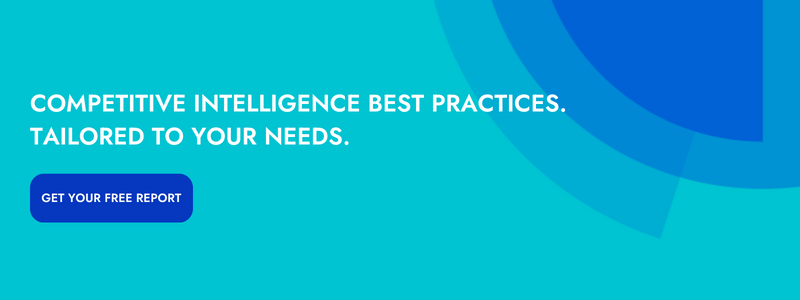So, you’ve gone through all the work of implementing competitive intelligence. You’re off to the races — tracking, analyzing, and activating valuable intel left and right… now what?
Implementing a competitive intelligence process is just the first step. Now that you’re armed with all of these valuable (and actionable!) pieces of information, it’s time to close the loop on CI at your organization.
As you know — all of that tracking, analyzing, and activating of CI doesn’t happen overnight, it’s an ongoing process and therefore requires ongoing monitoring. If you want your CI function to grow stronger and more effective over time, you need to establish methods of measuring impact.
KPIs are essential to practically every initiative, and competitive intelligence is no exception — with 67% of companies with an advanced CI function stating that they have a set of clearly defined competitive intelligence KPIs.
And although KPIs haven’t been used to determine the success of competitive intelligence for very long, the adoption of competitive intelligence KPIs is rising across the board — with 74% of all companies with a dedicated CI program stating that they have begun the process of defining KPIs.
Let’s take a closer look at how you can begin defining competitive intelligence KPIs at your organization and the top CI KPIs you should be tracking.
How do you measure competitive intelligence?
The key to accurately measuring the impact of your CI process is setting the right competitive intelligence goals and analyzing the right KPIs. Of course, this can be easier said than done.
Since no two competitive intelligence programs are the same — every company tracks a different set of competitors, every department activates CI for different purposes, and every practitioner is communicating on their own level of CI fluency — the metrics used to measure competitive intelligence differ from company to company.
So, before you dive headfirst into measuring the success of your CI program, take the time to determine clear, quantitative and qualitative metrics that align to your competitive intelligence goals.
For example, if the primary goal of your CI program is to produce comprehensive and actionable sales enablement materials, the metrics you’ll want to focus on are tied closer to the sales team — like battlecard engagement rates and win/loss rates.
Top 4 Competitive Intelligence KPIs to Track
To ensure you continue reaping the benefits of your competitive intelligence program long after it has been implemented, here are the top CI KPIs you should be tracking.
1. Stakeholder Confidence
One of the benefits of a healthy CI function is that competitive intelligence stakeholders are able to make the right decisions at the right times — and to do so with confidence. With a clear understanding of what’s going on outside the four walls of the organization, the sales rep is confident in their objection-handling abilities. The marketer is confident in their copywriting abilities. The executive leader is confident in their long-term planning abilities.
With this in mind, one way to measure the effectiveness of your company’s CI function is to periodically survey your stakeholders and ask them about their confidence levels. If your sales team is more confident this quarter than they were last quarter, that speaks to the quality of the deliverables you’ve given them. And if your marketing team’s confidence level is slipping, that may indicate a need for additional support.
2. Win Rate & Competitive Win Rate
Win rate refers to the rate at which your sales team converts opportunities into customers, and competitive win rate refers to the rate at which they turn competitive opportunities into customers.
To calculate win rate — divide won opportunities by total opportunities.
To calculate competitive win rate — divide won competitive opportunities by total competitive opportunities.
Although competitive win rate is a useful KPI in and of itself, you should also consider tracking the ratio of competitive win rate to overall win rate. If, over time, that figure keeps moving closer and closer to 1, that’s a great sign.
If your win rates aren’t where you want them to be, here are 13 Sales Enablement Tools to Increase Your Competitive Win Rate.
3. Customer Retention Rate
Customer retention rate refers to the rate at which your company uses competitive intelligence to retain customers over time. It can be calculated using the following formula:
[(E-N)/S]*100
Here, E is the number of total customers at the end of the period, N is the number of new customers added throughout the period, and S is the number of total customers at the start of the period. The time period you use — monthly, quarterly, yearly — is up to you.
No matter what, an improvement in customer retention rate can indicate (1) that your colleagues are doing a better job of combating objections and (2) that your products and/or services are doing a better job of delivering unique value to the market.
4. Revenue Growth
With improvement in net new business generation and customer retention comes improvement in revenue growth. Make sure to keep track of this (high-level) KPI, as it’s often the most universally resonant one.
More specifically, tracking influenced revenue from your CI efforts allows you to measure the amount of revenue tied to actual engagement from CI deliverables, e.g. specific battlecards.
Oftentimes the biggest challenges facing CI programs is how difficult it can be to generate buy-in from senior stakeholders who underestimate the value of competitive intelligence. By tracking influenced revenue, you can determine the monetary impact that your CI program has on your organization in a way that is more digestible for those stakeholders you still need to convince.
For example, if during a discovery call with a prospect they mention a competitor and a member of your sales team views that competitor’s battlecard before closing the deal, influenced revenue is equivalent to the amount of the closed deal.
Whether you’re speaking with colleagues in sales, product marketing, product, or the C-suite, pointing to CI-influenced revenue growth is sure to make a strong impression. Just make sure to present it alongside some of the other KPIs we’ve outlined here, as doing so will help to validate your claim that CI is driving revenue.
Reaching your Competitive Intelligence Goals with Crayon
No matter the specifics of your CI goals or which KPIs you are prioritizing, a dedicated competitive intelligence program allows you to reach new heights and achieve a greater competitive advantage.To ensure your competitive intelligence program is up for the task, check out our new and improved Guide to Competitive Intelligence. Inside you’ll find all the tips, tricks, and tactics you need to design a competitive intelligence program that achieves your CI goals.
.jpg)
Related Blog Posts
Popular Posts
-
 How to Create a Competitive Matrix (Step-by-Step Guide With Examples + Free Templates)
How to Create a Competitive Matrix (Step-by-Step Guide With Examples + Free Templates)
-
 The 8 Free Market Research Tools and Resources You Need to Know
The 8 Free Market Research Tools and Resources You Need to Know
-
 Sales Battlecards 101: How to Help Your Sellers Leave the Competition In the Dust
Sales Battlecards 101: How to Help Your Sellers Leave the Competition In the Dust
-
 6 Competitive Advantage Examples From the Real World
6 Competitive Advantage Examples From the Real World
-
 How to Measure Product Launch Success: 12 KPIs You Should Be Tracking
How to Measure Product Launch Success: 12 KPIs You Should Be Tracking





